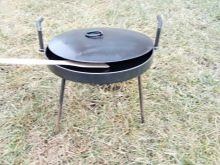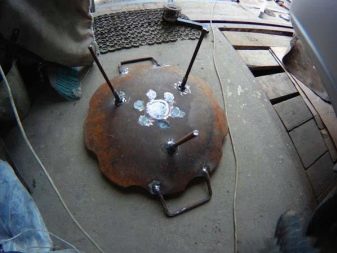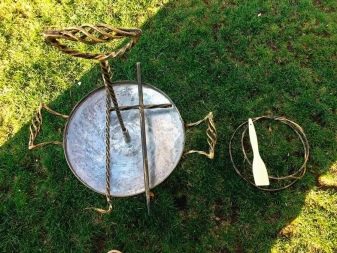Making a frying pan from a harrow disc

A frying pan is a kitchen appliance designed for frying and stewing food. Has a flat or semicircular bottom. Can be equipped with a handle for holding during heating. The main materials from which pans are made are: steel, cast iron, aluminum, stainless steel. There are modifications of frying pans that you can make yourself. One of the most common ways to make this device is to alter the harrow disc.



Peculiarities
The harrow is an agricultural device with which the soil is plowed. It has a round convex-concave shape. Some harrow varieties have a cutting edge that contains wide tines. Made of robust steel up to 1.5 cm thick. There are mounting holes in the center of the harrow to hold the harrow in position on the drive unit.
The properties of the material, its thickness and the size of the diameter make the harrow a suitable workpiece for making a homemade frying pan.


A wok made from a harrow is ideal for field use. It can be installed on makeshift campfire props, as well as on a special tripod used to hold a round-bottomed cauldron. When making a frying pan from a harrow on your own, you can equip additional fasteners that allow you to attach support legs to it, which significantly expands its functionality and makes it universal.



Instruments
The process of making a frying pan or wok from a harrow is associated with the processing of metal products.Taking this into account, it is necessary to prepare a minimum list of tooling accessories that will allow you to perform this work. The main toolbox contains:
- welding machine;
- angle grinder;
- hammer;
- vice;
- measuring devices (tape measure or ruler);
- other related tools.



A welding inverter will be needed to eliminate the holes located in the central part of the harrow and attach additional elements. The grinder is necessary for cutting metal workpieces and their processing, as well as for cleaning welded seams. Before using it, you will need to prepare cutting and grinding wheels, attachments for cleaning and polishing.
The use of a hammer is paramount when welding. With its help, slag deposits that arise in the process of overheating of the metal at the point of welding and cover the welded seam are beaten off. Defective areas of connecting joints: cracks or voids can be located under these deposits. By beating the slag with a hammer, you can identify these defects and eliminate them.


A vise is encouraged, although not required. They help to hold the workpiece in a stationary position, which makes it easier to process it. Without a vise at hand, the workpiece can be fixed in any convenient way. Measuring devices are used to measure the dimensional parameters of workpieces, which is necessary in the manufacture of fasteners for the support legs of the pan.
In the process of reworking the harrow disc, other tools may be added to the pan, which is determined by the characteristics of the finished product.

Materials (edit)
The main component of a home-made frying pan is a harrow made of durable thick-walled steel. The rest of the elements are intended to give it the proper functional form. The following materials can be used to remove the mounting holes:
- metal plate;
- iron rod;
- bearing balls;
- other available items.


The thickness of the metal plate must match the wall thickness of the harrow. This will eliminate the fastening holes without disturbing the inside of the pan or the outside bottom of the pan. The diameter of the iron bar should match the diameter of the holes located in the center of the wok. If the value of its diameter is less than the size of the diameter of the holes, then the excess space between the rod and the inner edge of the hole can be filled with a pipe cut of the corresponding diameter or other metal inserts.
If the diameter of the rod is greater than the diameter of the holes, the best solution would be to equalize these values by grinding the rod. Reaming the holes is not considered cost-effective because the harrow's metal is thick and durable. Using bearing balls to cover the mounting holes in the harrow is the best way to accomplish this task. The main difficulty here is finding balls with a sufficient size of the diameter.
Suitable items might be tractor bearing balls, which can be found among parts in most auto dealerships.
To ensure the convenience of using the pan, it is worth welding the U-shaped handles to the edge of its edge. They can be made from reinforcement or a small diameter iron rod.


Hole Removal Methods
The harrow mounting holes, the diameter of which ranges from 15-20 mm, are located in the center of the workpiece, which prevents it from being used as a frying pan. Removing them with a metal plate can be done in two ways. In the first case, 2 parts of the plate are welded on both sides of the harrow so that the holes are completely covered.Welding is carried out along the perimeter of the plate elements, which will eliminate the occurrence of a leak.
The area where the inner and outer plates are located is cleaned with a grinder and a corresponding nozzle. Particular attention is paid to the internal welds, as they will come into contact with food that is being cooked in the pan. The presence of cracks and voids in the seams will contribute to the ingress of food particles into them, which is undesirable. A second method of using a metal plate to remove holes in a harrow is to make circular closures that match the diameter of the holes.

The contour of each hole is transferred to the surface of the plate, after which the sawing is performed using a grinder and a cutting wheel. The resulting "tablets" are inserted into the holes and scalded along the line of their contact with the inner edges of the holes. By using a metal rod, the task of plugging holes is simplified. The rod is inserted into the hole and scalded. Then its excess parts are cut off. To facilitate this work you can pre-saw off from the rod blanks, the length of which is equal to the wall thickness of the harrow.
If there are bearing balls of the corresponding diameter, the holes are removed as follows: the ball is inserted into the hole so that it cannot be seen in the inside of the pan. Procooking is in progress. The depression that forms above the welded ball is filled with liquid metal of the consumable electrode. In the finished form, the frying pan, in the manufacture of which the bearing balls were used, will have rounded protrusions at the bottom. These protrusions serve as support feet, allowing the pan with a semicircular bottom to be placed on level surfaces.
For information on how to make a frying pan from a harrow disc, see the next video.
The final stage
In order for the frying pan from the harrow to be used in field conditions, four pieces of pipe with a length of at least 10 cm are welded to its bottom. The distance between them must be equal, which will ensure effective distribution of loads.... Support legs will be inserted into these tubes, the height of which should allow the pan to be set over the fire. At the final stage of making a frying pan from a harrow, the surface of the inner side is thoroughly cleaned and then polished.
Any coatings applied to the harrow must be removed, as when heated they will release toxic substances that are incompatible with cooking for humans.
When sanding surfaces, it is important to achieve maximum smoothness.... The absence of scratches and grooves left by abrasive materials will prevent food from sticking to the surface of the pan and subsequent burning of the food. Since the harrow is the cutting element of the tractor plow, its outer edge must be carefully processed. Using a grinding wheel and a grinder, the edge of the pan is rounded off.
Next, you need to perform a primary calcination at the stake, which will reveal design flaws, if any.










